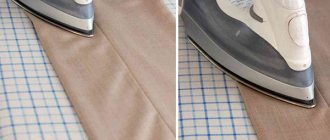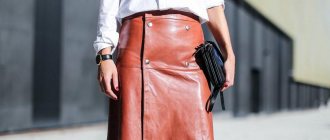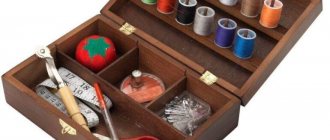A shirt made of cotton fabric is one of the elements of classic clothing for men and women.
Natural material has many advantages, but it wrinkles a lot.
To properly iron a cotton shirt, you must adhere to the appropriate rules. Read on to learn how to properly iron a cotton shirt.
Where do you start ironing a shirt?
To save effort and time, prepare in advance everything you need:
- Iron with a perfectly clean surface. To do this, it must be washed regularly using special products purchased at hardware stores. For some surfaces, folk remedies will also be effective: salt, paraffin candles, vinegar, hydrogen peroxide, etc. In addition, modern irons have a self-cleaning function.
- Ironing board
- Container with water
- Household sprayer , in case the iron does not have a steam function.
- Gauze cloth or scrap of cotton fabric . You can do without underwear if you are sure that the iron does not leave marks on things.
Sleeves
The true skill of the housewife is considered when the sleeves are ironed without arrows. While ironing the sleeve, make sure that the fabric is evenly positioned on the board, slightly pulling at one edge, adjusting the material so that folds do not appear. Iron from the front and back, and finally the top of the sleeve in the place where the arrow most often forms. It is easier to iron a shirt with a short sleeve; it uses the same technology as for a long sleeve, but without a cuff. Many ironing boards come with a sleeve ironing board; if that element is missing, you can use a roller made from a regular folded towel. The roller is inserted into the sleeve and ironed.
The sleeve ironing board is a miniature copy of an ironing board
What mode should you use to iron a shirt?
The operating temperature of the iron depends on the type of fabric the shirt is made from. To do this, examine the shirt label. It contains all the necessary information on product care and fabric composition.
| Designation | Decoding |
Dry ironing or steamingTo restore the shape and appearance of the product, it can be ironed at any temperature, with or without steam. | |
Iron at low temperatureAllowed to iron at a maximum temperature of 110°C (corresponds to the symbol in the form of a single dot on the iron’s thermostat), acceptable for synthetics, nylon, acrylic, polyester, polyamide, acetate, use a fabric pad, do not use steam | |
Iron at medium temperatureAllowed to iron at a maximum temperature of 150°C (corresponds to the symbol in the form of two dots on the thermostat of the iron), acceptable for wool and mixed fibers with polyester and viscose; Ouch; use a damp cloth | |
Iron at high temperatureAllowed to iron at a maximum temperature of 200°C (corresponds to the symbol in the form of three dots on the iron’s thermostat), acceptable for linen and cotton; You can slightly moisten the product | |
Do not steamIroning with steam will damage clothes; regular ironing at the specified temperature is recommended. | |
Do not ironThe product should not be ironed, steaming or steam treatment should not be used. |
Modern irons are equipped with a temperature sensor and have instructions for determining the heating temperature.
In more outdated models, temperature is determined by dots:
- one point - temperatures up to 110 degrees;
- two points - temperature up to 150 degrees;
- three points - temperature up to 200 degrees.
If your iron has a steam mode, you should check the purity of the steam before ironing. To do this, turn on steaming on a test fabric: gauze, handkerchief.
If there is no tag , then you need to choose a mode depending on the composition of the fabric:
| Fabric type | Ironing temperature, ℃ |
| linen | 190-230 |
| cotton products | 165-190 |
| woolen items | 140-165 |
| pure silk | 115-140 |
| things made of viscose | 85-115 |
It is easier to iron a synthetic shirt, because... it is less susceptible to creases. But with cotton you will have to suffer.
Hanging the cotton shirt flat on a hanger and letting it dry, ideally in the fresh air. This will help make ironing easier.
The cotton shirt should be slightly damp before ironing. Iron temperature should not exceed 160 degrees. If it is dry, it can be ironed through damp gauze.
Sequence and technique
Ironing a men's shirt is carried out in a strictly defined sequence: first the collar, cuffs and sleeves. Then - the bar, shelves and back. Iron small parts first, then move on to large ones.
Iron the collar from the inside out. Start from the corners and move towards the middle. Repeat in the same way on the front side. If folds appear, pull them towards the base of the collar. It is prohibited to bend it along the stand and iron it in this position. If the shirt is damp, smooth the collar until it is dry.
The cuff, like the collar, is first ironed from the inside out, then from the front side. A more complex technique for ironing a double cuff. Unfold it and iron on both sides without folding. Now fold and give the desired width. Press along the fold so that the buttonholes lie on top of each other.
Let's move on to the sleeves. The algorithm of actions is labor-intensive, but simple. Fold the sleeve in half and press the seam down the middle. Turn over and iron on the other side. Fold along the seam and iron from seam to edge. Do this so that there are no folds in the fabric. For convenience, use a special ironing board element. Just pull the sleeve over it and iron it in a circle.
Let's start ironing the shelves. This is the front part of the shirt, which consists of two halves. One of them is easier to iron - there are no buttons. On the second, you will have to maneuver the tip of the iron without creating creases. Try not to touch the hot sole to the decor, even if it is covered with a strip of fabric. Smooth the shelves from top to bottom. If there is a pocket, iron it in the opposite direction. Press the iron firmly onto the fabric.
Place the back of the shirt on the board, right side down or wrong side down (depending on the type of fabric). Go along the side seam first. Then move up along the sleeve seam. Unfold the shirt and work on the yoke and midsection. Turn around again - the left side of the yoke. Then seam the left sleeve and down to the side seam.
Is it possible to iron a shirt immediately after washing?
Shirts prepared for ironing must be washed and dried.
After ironing, shirts that have been worn at least once will not look fresh.
Do not iron wet or overly dry items.
The optimal moisture content of a shirt is if no moisture is released when you press it. If you use the “crease-free” mode during washing, this will simplify the further process.
A dry shirt can be moistened with clean water from a spray bottle.
Steamer from inside
Having figured out what type of steamer you want to purchase, you should also think about the “filling” of the device, because some types give more steam, while others less.
Here everything depends on the heating elements, which, according to the material of manufacture, can be steel or made of brass.
There is an opinion that brass as a material is more durable. But it is not so. The properties of this element are such that brass has less corrosion resistance, which does not affect the service life of the device.
Please note: Latest model steamers consist of a tank, pump, heater and valve. A simple mechanism provides steam, the power of which depends on the power of the heating element. In conclusion, a few more words about the configuration of steamers
In conclusion, a few more words about the configuration of steamers.
When buying, you should also pay attention to this. Almost all steamer models have the following equipment:
- brush,
- trouser clips,
- protective mitten,
- devices for collar and pocket steamers,
- clothes hangers that conveniently hold items in place for ironing.
If you are still in doubt about your choice, you can always ask the question you are interested in to the consultants in the stores.
General algorithm for ironing a shirt
Ironing should begin with small elements, so novice housewives need to divide the product into zones to simplify the work:
- collar
- buttons
- cuffs
- sleeves
- back
- front side
Collar
When ironing the collar area, it is recommended to use the steam mode on the iron. If there is none, then use water and a spray bottle to moisten the collar.
Do not stretch the collar fabric, keeping it in place in a flat position.
The collar is looked at in 3 stages:
- wrong side
- front side
- giving the collar the desired shape
We smooth out the area under it well - the place of the dart, the joint, the stand. This is especially important for shirts that are worn without a tie.
Button area
Carefully iron between the buttons with the “nose” of the iron, pointing it towards the sleeve.
Iron the button area on both sides.
We avoid getting the iron on the buttons, which, if they come into contact with a hot sole, can cause damage and damage the fabric.
Cuffs
The cuffs are ironed after unrolling them. First, the cuff strip is ironed. Then the cuff itself from the inside, and then from the front side.
Carefully iron all the grooves on the cuffs.
Sleeves
We iron the sleeve up to the stitching seam, lightly touching it. You can use a sleeve - a device for an ironing board that imitates the shape of a sleeve.
Iron the sleeve without smoothing its edges - only the middle, gradually turning it.
Back of the shirt
Ironing the back of a shirt occurs in three areas:
- middle
- two side parts
We iron them each in turn, gradually moving the shirt and not touching the ironed collar and sleeves of the shirt.
Front side
Let's move on to the front side of the shirt. Ironing the right and left sides in turn, we try not to form microfolds under the iron.
Iron the front side to the yoke, collar and sleeve. We go over the iron again under the collar stand. We pay attention to the pocket flaps on the front side, if any.
Now the shirt looks perfect and you need to fold the shirt correctly or hang it on hangers.
Place the shirt on the ironing board and fasten all the buttons. If necessary, you can iron small parts or creases that formed during the ironing process.
The GQ style video encyclopedia shows how to iron a shirt:
Do I need to smooth the arrows?
The rules of etiquette do not have an exact answer to this question. In fact, the presence of arrows or their absence is a purely personal matter. However, this element is not desirable in women's outfits. It may well be for men, but most often it is used only for formal events. For everyday wear there is no need to iron the arrows. They look especially strange on short sleeves.
There is a strong opinion that arrows should be on the clothes of representatives of law enforcement agencies. True, similar details can also be seen among top managers at large enterprises and even among political figures. In fact, they are appropriate only for formal occasions, but in everyday life it is better to do without them.
If there are arrows, the look can be complemented with a tie, vest or suit. Only formal shoes are appropriate. You can also decorate the cuffs with cufflinks.
How to iron a shirt without an iron?
Hot iron mug
A mug or any pan is suitable for ironing. The larger the diameter, the more surface it will cover at one time. A kettle that boils water on the stove is also suitable.
It is necessary to pour hot water into a metal container and run it over the fabric. This method is still suitable today, it is simple and fast. The bottom of the container must be clean, otherwise it will contaminate the shirt.
Video example of ironing using a pan of hot water:
Steam in the bathroom
For this time you need a reserve of about 20-30 minutes. Fill a bath with hot water and hang a shirt over it on hangers.
The steam will straighten the folds, the fabric will stretch and after 20 minutes it will be “ironed”.
You can't put the shirt on right away. You need to remove it from the bathroom and let it dry.
It should be taken into account that this method requires a large volume of water, which imposes additional costs.
Steam from a boiling kettle
Boil a kettle and place a wrinkled shirt under the steam from the spout. Proceed with caution to avoid getting burned.
Self-smoothing solution
- Dissolve a little vinegar and fabric softener in water. Mix and pour the resulting solution into a spray bottle. The solution does not leave stains on fabric.
- Moisten a neatly laid out shirt with the solution and wait for it to dry. The wrinkles will be smoothed out and the clothes will look neat.
Water and hairdryer
Spray the fabric with plain water and dry with a hairdryer. The effect is less noticeable than after a vinegar solution, but it will be noticeable.
Stretching and pressing
This method takes a long time.
- You need to carefully lay the shirt down and straighten out every fold.
- Place a heavy and large object on top so that its surface completely covers the clothing. For example, a mattress so that the clothes are under the sleeping person all night. The effect will be enhanced if you spray the shirt with a vinegar solution or plain water before doing this.
Wet towel
- Wet a terry towel and squeeze thoroughly.
- Spread it on a flat surface (floor, table, bed). Place the shirt on top and carefully straighten out the folds. When exposed to moisture, the fabric will smooth out.
This process requires one to two hours. The shirt will be ironed, but very damp. You will need to dry it on hangers in a well-ventilated area.
This method is suitable for clothes made of wool, cotton and synthetics.
Hair straightener
- Clean the inside of the tongs to prevent stains from appearing on the fabric.
- Heat the device to a high temperature and, holding the shirt with it, move it from top to bottom.
It is convenient if the shirt hangs on hangers, and not lie horizontally.
It is easy to iron the sleeves, collar and bottom edge of clothing, but it will be difficult to straighten other, larger and wider areas. For larger surfaces, you can use a pan of hot water. This method is suitable for smoothing out individual large folds.
How to iron with a light bulb?
Similar to using hot iron cookware. Option for using the light bulb:
Option 1
- unscrew the hot light bulb with your hand wrapped in a towel
- move it over the fabric instead of an iron
Option 2
- lift clothes to the lamp
- vigorously move the clothes over it.
The wrong side of the shirt should be in contact with the light bulb. This will protect it from stains. Before ironing, wipe the lamp with a damp cloth to remove accumulated dust.
The warmth of your body
If you put a wet item on yourself, the body heat will smooth out the creases. This is not the most pleasant method, but it is effective.
If you first spray the fabric with a vinegar solution, the result will be improved. True, you will have to inhale vinegar fumes, which is unpleasant and not very useful.
Useful video reviewing ironing without an iron:
Classification of steamers
According to their design and purpose, steamers come in various types, among which are:
- Hand steamer;
- Steamer with a vertical stand;
- Steam cleaners;
- Professional steamers.
The first type of steamer is manual, the simplest and most convenient to use. Low power and affordable price make it easy to use when traveling, where it is not possible to use an iron. Another feature of them is that they can be used as a small kettle to boil water on the go.
The first type of device has a tank, the volume of which is designed to steam clothes for 10-15 minutes. During this time, you will have time to iron two or three things from your suitcase.
Good steam, stylish design and small size are the main advantages of this category.
Most often, these steamers with a stand have only one mode, low power, a plastic iron, simple controls on the body and a relatively small tank volume. Also in this category, the equipment is modest and there is no possibility to add water at any time.
An important point: Steamers from the second subgroup already have higher power, which is why their effectiveness is an order of magnitude greater.
Powerful steam flow, control is already on the handle, which is more convenient. The metal iron in some models has an additional heating function. The large tank has the ability to add water. Another advantage of these senders is several modes that allow you to reduce and increase power. This feature is useful if you have fabrics that are sensitive to hot air in your wardrobe.
The third type includes steam cleaners. These are devices that combine two devices at once - a steamer and a steam cleaner. If you need sterile cleaning at home, then you cannot do without this “machine”. Hot steam helps bacteria disappear and various contaminants are cleaned away.
With such a steamer you can even clean off grease that has accumulated on the surfaces of the stove, mirrors, in the oven, or wash the tiled floor with a steam mop. This option is especially relevant in families with children.
The fourth type is professional devices, which are usually installed in stores, in the theater costume department, in clothing stores and other similar places. But, if desired, they can be installed at home.
Steamers of this type are characterized by high power, which allows them to work for a significant amount of time without interruption. The tank has a large volume, there are some functional parts for professional use, for example, a convenient frame hanger.
Neat clothes without ironing
If you don’t want to waste time using an iron, you can use alternative ways to wear neat and ironed clothes. Knowing the composition of the fabric, you can estimate the degree of its wrinkleability.
Natural fabrics such as linen, natural silk, muslin, cambric are prone to the rapid appearance of untidy creases.
Clothing with synthetic fibers retains its shape longer and is easily smoothed out after washing if clothes made from it are dried on hangers or flattened on a flat surface.
Denim
Denim is a coarse, stiff, dense twill fabric that Levi Strauss used to sew the first classic jeans. They sew from it:
- trousers,
- shirts,
- jackets,
- dresses and other things
There are many reasons for their popularity, one of which is: you don't need to iron them! This is a dense material that is resistant to deformation and retains its shape.
Crash
This fabric has a small fold, with an initially wrinkled effect. It makes stunning shirts!
Tips for choosing
When going to a hardware store, you should pay attention to the control units. There are mechanical and electronic
With a mechanical control unit, the device is configured and adjusted manually. Electronically controlled models require pre-installation of all necessary parameters, which can be viewed on a special display. Although their price is much higher, they provide additional convenience and time savings.
Each of the steamers has its own technical characteristics, the main of which are power, tank volume, weight of the device, method of steam supply and the material from which it was made. Don’t lose sight of the additional functions that make the process of steaming and disinfecting fabrics even easier.
It is important not to strive to buy the latest new products, which after a short period of time cease to be so. The purchased item should please you with its quality and long service life
And you can increase it by following all the rules of proper operation.
If it's not 100% cotton? What to do?
Yes, cotton is unpretentious and not too capricious, but nowadays clothing manufacturers are increasingly adding synthetic impurities to the main composition of your products.
They make it easier to care for, since such fabrics are not so deformed and have an impressive wear life.
Such a mixed structure needs appropriate adjustments so that changes in this factor do not affect the appearance. That's why:
- Wash such items at 40 degrees, since at high levels it becomes deformed;
- Place in a separate bag and set the machine to the option of washing delicate fabrics or with the light ironing function - to minimize creasing;
- Refuse automatic drying; just spin at maximum power;
- Dry clothes according to the instructions in the instructions;
- Take note of the temperature indicated on the label.
We help solve any difficulties...
Household chores take up a significant portion of your time. A whole series of household chores falls on fragile women's shoulders. To make this fate easier, we will tell you in detail how easy and simple it is to put a shirt made of natural cotton in order - to remove all the folds, unevenness and bruises.
Ironing is a special procedure that brings a lot of unpleasant troubles, which are not always possible to cope with. Now, take a breath and sit down to read this useful article that will help you find a hassle-free path.
To properly organize the process at home, we provide useful recommendations. This way you will replenish your reserves of skills, abilities and wisdom, and your man will be grateful to you for your care, warmth and comfort.
Preparatory stage
The preparatory stage in ironing linen items is one of the most important, and under no circumstances should it be skipped. The quality of the ironed linen will depend on how thoroughly you prepare in advance. So, in the ironing process you will need:
- iron;
- ironing board;
- thick fabric for lining;
- container with sprayer.
If everything is clear with the iron and board, then dense material is needed to cover the ironing surface with it before laying out the linen on it. This will provide linen items not only with high-quality ironing, but also with a kind of protection.
A container with a sprayer is necessary to moisten the flax. When dry, this type of fabric is difficult to iron, and sometimes even poorly. You can moisten textiles with either plain water or a special conditioner for flax. In the latter case, the textile product is additionally scented. Some housewives recommend not immediately drying linen items completely after washing, but leaving them slightly damp and putting them on the ironing board in this form.
It is very important to choose an iron suitable for linen. A unit with the necessary parameters will not only iron textiles correctly, but will also greatly facilitate the entire ironing process.
When choosing the described device, we recommend that you first pay attention to its weight. Despite the fact that almost all modern irons are lightweight, heavier irons are ideal for ironing linen
Because of their weight, they iron out every wrinkle efficiently, but you have to apply a lot of pressure on a lightweight unit to get this result. Agree, this is not very convenient, because in such conditions your hands will get tired after ironing the first product.
The ironing handle also plays an equally important role. The ease and comfort of the ironing process depends on how comfortable it is. In addition, for high-quality ironing of linen, it is better to use an iron equipped with a steaming system. In this case, the holes should be located throughout the sole of the unit. When they are in one place, it is impossible to steam things properly.
Advice! Give preference to irons with ceramic soles.
Security measures
To use a handheld or vertical steamer, you must follow safety rules. When working with the device, you must pay attention to:
- According to the instructions, assemble the device correctly;
- do not direct hot steam onto the body;
- fill the container with water after disconnecting from the network;
- do not carry out repairs yourself;
- After use, wipe all parts and attachments dry;
- do not give the steamer to children;
- Do not clean the device with brushes or detergents.
Additional features
The steamer not only irons things, but also helps when cleaning the apartment. Under high pressure, steam breaks down dust, removes bacteria and cleans the room. Let's consider some of the capabilities of the unit in everyday life.
- Steam can be used to clean tiles in the kitchen or bathroom. The brush attachment removes heavy dirt without the use of detergents. The surface is treated with steam and wiped with a dry cloth.
- In the kitchen, a steamer will clean the stove, sink, hood, corners and hard-to-reach places on the radiator.
- During repairs, hot steam will help remove old wallpaper on the walls.
- Disinfection of upholstered furniture and toys.
- Cleaning the interior of a car.
- Removing greasy and old stains in the kitchen.
Volumetric things
When ironing bulky items (duvet covers, sheets, tablecloths), you first need to fold them several times and then run a hot iron on all sides. Often such items have elements of embroidery; it is better to iron them through a soft cloth. It is better to place it under the wrong side and on top of the front side, so the colored embroidery will not leave an imprint. If you iron the embroidered area from the inside out, you will be able to preserve its relief. To avoid distortions after ironing, duvet covers and other large items should be slightly pulled in the direction of the longitudinal thread.
A little history about cotton
This fabric, imagine, is more than 7000 years old! Today, cotton fabric is woven from 30 different types of plants.
. Cellulose fibers give the material special strength. In addition, it absorbs moisture well, which is why cotton towels are very popular among housewives.
But the most important quality for which we all appreciate cotton is that it is extremely pleasant to the body.
. These clothes look good in both winter and summer. Cotton is especially good for children - it is a hypoallergenic material, so pants, vests, T-shirts and shorts for babies are made mainly from 100% cotton.











